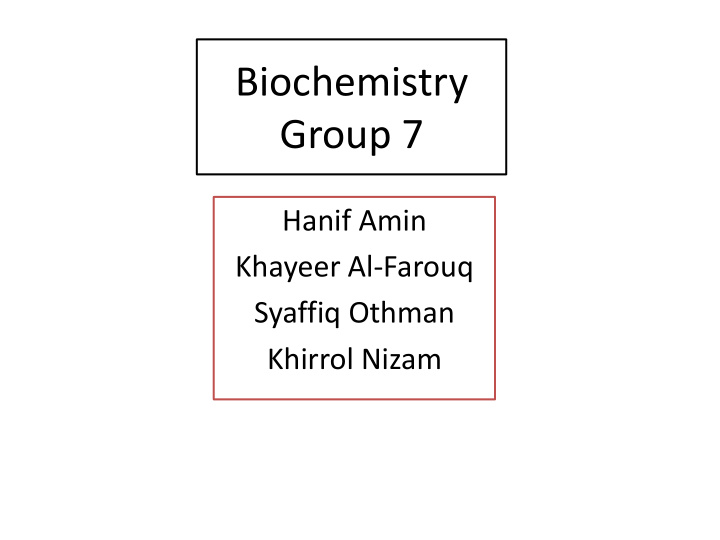



Biochemistry Group 7 Hanif Amin Khayeer Al-Farouq Syaffiq Othman Khirrol Nizam
LIST CHEMICAL THAT INHIBIT PARTICULAR ENZYME IN GLYCOLYSIS AND THEIR MECHANISM OF INHIBITION By Hanif Amin D11B043 Khayeer Al-Farouq D11B040
Glycolysis • 1 st series of reaction that breaks glucose apart to liberate energy it holds • Takes place in cytoplasm of cells. Also with absence of O2 • Involves 10 steps • Divided into 3 stages 1 st phase - An energy investment 2 nd phase – Cleavage into 2 molecules 3 rd phase – Liberates energy
Glycolysis diagram
Enzyme inhibition • Competitive enzyme inhibition – competitive blocker at the active site • Non-competitive enzyme inhibition – non- competitive blocker causes conformational changes
List Of Chemical & Mechanism Of Inhibition Chemicals Mechanisms of inhibition 2-Deoxyglucose -Inhibits phosphorylation of glucose by hexokinase -Inhibits glycolysis and mitochondrial respiration Lonidamine -Inhibits HK; disassociating HK from mitochondria 3-Bromopyruvate -Inhibits HK; acts as an alkylating agent Imatinib -Inhibit Bcr-Abl tyrosine kinase; causes a decrease in HK and G6PD activity Oxythiamine -Suppresses PPP by inhibiting transketolase; inhibits pyruvate dehydrogenase Abbreviations: HK, hexokinase; G6PG, glucose-6-phosphate dehydrogenase; PPP, pentose phosphate pathway.
2-Deoxyglucose • Act as competitive inhibitor. • Inhibition of glycolysis at the step of phosphorylation of glucose by hexokinase. • Its reduced avaibality of glucose for glycolysis. • A clinical trial suggest that 2-DG at dosses up to 250mg/kg appears safe for use combination with radiation therapy.
Lonidamine • Inhibit aerobic glycolysis in cancer cell. • Its suppress glycolysis in cancer cells, through inhibition of the mitochondrially bound hexokinase. • In ehrlich ascites tumor cell showed that lonidamine inhibits glycolysis in a dose- dependent manner, lead to decrease in cellular ATP.
3-Bromopyruvate • Inhibitor of hexokinase and has been shown to abolish ATP propduction and cause severe depletion of cellular ATP. • Exhibits potent cytotoxic activity against cancer cell with mitochondrial respiratory defects. • Its cause rapid dephosphorylation that lead to massive cell death. • Animals studied show 3-BrPA has significant therapeutic activity against liver cancer when given local infusion.
Female rat "R4" before treatment with 3-bromopyruvate (left) and 4 weeks after treatment with the compound. The tumor is gone from the animal's right shoulder.
Imatinib (Gleevec) • It is a inhibitor that designed to specifically target BCR-ABL. • Imatinib tx decreased the activity of both hexokinase and glucose-6-phosphate dehydrogenase ( G6PD) in leukemia cells. • Leading to suppression of aerobic glycolysis. • Imatinib is an antileukemia drug, but also useful for tx of certain solid tumors.
Oxythiamine • Inhibits transketolase and pyruvate dehydrogenase. • Oxythiamine is phosphorylated to yield diphosphate ester which then act as strong competitive inhibitor against normal cofactor TPP ( thiamine pyrophosphate). • This metabolic inhibitions seems to be responsible, at least in part, for significance anticancer activity in vitro and in vivo.
TASK 2 Calculate total ATP produced from glycolysis and tricarboxylic acid cycle per one glucose By Khirrol Nizam D11A014
Glycolysis Phase 1, 2 ATP are used ; 1 ATP used for the conversion of glucose to G6P, 1 ATP used for the conversion of F6P to F1,6BP
Glycolysis Phase 2, 4 ATP are produced from substrate level phosphorylation; 2 ATPs are produced from the conversion of two molecule of 1,3BPG to two molecule of 3PG 2 ATPs are produced from the conversion of two molecule of PEP to two molecule of pyruvate Nett ATP produce is 2 ATP only
Glycolysis 2 NADH is produced from the conversion of two molecule of G3P to 1,3BPG. The 2 NADH may undergo oxidative phosphorylation via; Glycerol-phosphate shuttle which produced 4 ATP; or Malate-aspartate shuttle which produced 6 ATP Sub total ATP produced by glycolysis; 6 ATP or 8 ATP
Link reaction: pyruvate to acetyl CoA 2 NADH are produced from the conversion of pyruvate to acetyl-CoA The 2 NADH undergo oxidative phosphorylation which produce 6 ATP Sub total produced by link reaction is 6 ATP
Tricarboxylic acid cycle (TCA cycle/ citric acid cycle/ Krebs cycle) 2 ATP are produced from substrate level phosphorylation from conversion of two molecule of succinyl-CoA to two molecule of succinate
Tricarboxylic acid cycle (TCA cycle/ citric acid cycle/ Krebs cycle) Two cycle of TCA cycle will produce 6 NADH and 2 FADH 2 The 6 NADH will undergo oxidative phosphorylation which produce 18 ATP The 2 FADH2 will undergo oxidative phosphorylation which produce 4 ATP Sub total ATP produced by TCA cycle id 24 ATP
Oxidative phosphorilation
• ATP yield per glucose molecules Process ATP Yield per glucose molecule Glycolysis Substrate level phosphorylation 2 ATP 2ATP Oxidative phosphorylation with 2 NADH: • Glycerol-phosphate shuttle 4 ATP • Malate-aspartate shuttle 6 ATP Link reaction: Oxidative phosphorylation with 2 NADH 6 ATP 6 ATP pyruvate to acetyl-CoA TCA Cycle Substrate level phosphorylation 2 ATP 2 ATP Oxidatibe phosphorylation with 6 NADH 18 ATP 18 ATP Oxidative phosphorylation with 2 FADH 2 4 ATP 4 ATP Total 36 ATP 38 ATP
LIST THE GLYCOGEN STORAGE DISEASE IN ANIMALS AND EXPLAIN THE MECHANISMS OF THE DISEASE By Syaffiq Othman D11B039
Generally, Cause by enzyme failure of glycogen to be released from the cell.
Therefore, conversion glycogen accumulates within the liver and other organs and is unavailable for conversion to glucose
TYPES OF GLYCOGEN STORAGE DISEASE
http://emedicine.medscape.com/article/1116574-overview
• Type I Von Gierke’s • Type II Pompe’s • Type III Cori’s • Type IV Anderson’s • Type V McArdle’s • Type VI Her’s • Type VII Tarui’s
Von Gierke disease Glucose-6- phosphatase deficiency Affect kidney & liver Type Ia & Ib
Pompe’s disease Cardiomegally Increase in glycogen Wide QRS
Cori’s disease alpha-1,6- glucosidase deficiency Affect liver & skeletal muscle debranching enzyme
Andersen’s disease amylo-1,4-1,6 transglucosidase deficiency Affect liver & heart branching enzyme
McArdle’s disease Affect skeletal muscle Increase in glycogen (cannot release glycogen from muscle) Myo Phosphorylase deficiency
Her’s disease Affect liver decrease in glycogen (Hypoglycemia) Hepatic Phosphorylase deficiency
Tarui’s disease Affect skeletal muscle and erythrocyte Phosphofructokinase deficiency More severe than type V
“http://www.petmd.com/dog/conditions/endocrine/c_mult i_glycogen_storage_disease#.T4xOTdmQk1g”
Recommend
More recommend